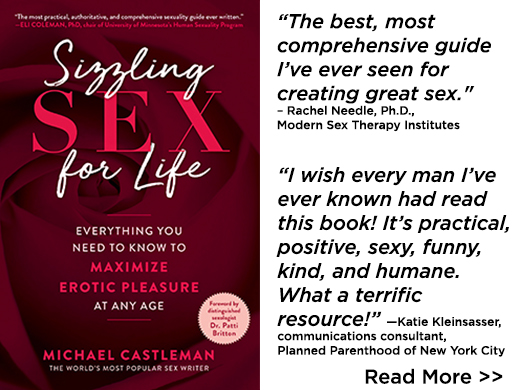
In both genders, orgasm difficulties are fairly common—and almost always curable
In partner sex, some people—both men and women—take quite a while to work their way up to orgasm. Sometimes, it’s situational. If you’re drunk, fatigued, in pain, taking antidepressant medication, or pre-occupied by emotional stress, it may take longer than usual. But some people usually or always take quite a while, which may engender self-doubt and relationship conflicts.
If you’re the one who takes “forever:”
- Cheer up. You CAN come. Most orgasm difficulties can be resolved with do-it-yourself approaches. If they don’t provide sufficient benefit, sex therapy almost always resolves the problem.
- Don’t apologize. Re-organize. Apologizing acknowledges the issue but does nothing to cure it. Instead, take a close look at your life and lovemaking, and try to pinpoint factors that might impair your ability to have orgasms.
- Use a lubricant. Saliva, vegetable oils, and commercial lubricants enhance the pleasure of sensual touch and often hasten orgasm. Commercial lubes are available over-the-counter at pharmacies. Look near the condoms.
- Only 25 percent of women are reliably orgasmic solely from vaginal intercourse. Three-quarters of women need direct clitoral caresses: gentle, extended, well-lubricated handjobs and/or cunnilingus an inch or two above the vaginal opening beneath the top junction of the vaginal lips. Several recent studies agree that a prime reason why women have orgasm difficulties is that their lovers don’t provide enough clitoral massage and cunnilingus.
- Limit alcohol. The first drink is disinhibiting. Alcohol makes people more likely to say “yes” to sexual invitations. But subsequent drinks depress the nervous system and may inhibit orgasm. As people age, alcohol-induced orgasm inhibition becomes increasingly likely. If orgasms are a problem for you, limit yourself to one drink within an hour or so of making whoopie. Narcotics, anti-anxiety medications, and other mood-altering drugs may also sabotage orgasm. Do you take any? Search the Internet and ask your physician and/or pharmacist if any drug you take might be contributing to your problem.
- Taking an SSRI? Ask about switching. SSRIs, selective serotonin reuptake inhibitors, are the most popular class of antidepressants. They include Prozac, Zoloft, Paxil, Celexa, Lexapro, Cipralex, Seroxat, Luvox, and Lustral. The SSRIs are notorious for causing sexual side effects, notably difficulty with orgasm. If you take one, ask your physician if you might switch to Wellbutrin (bupropion), an equally effective antidepressant with considerably less risk of sexual side effects.
- Relax deeply. Stress interferes with orgasm. Before you begin the horizontal dance, try a hot bath or shower—very relaxing. In addition, incorporate a stress-management regimen into your life: daily exercise, meditation, yoga, playing music, or anything else that leaves you feeling calm, refreshed, and emotionally renewed.
- Make love earlier in the day. With age, as the day progresses, erotic energy often ebbs. Try having sex earlier in the day. This also helps many young lovers.
- Spend more time in solo sex. Self-pleasuring teaches what turns you on and works you up to orgasm. For most people, as frequency of masturbation to climax increases, so does ability to have orgasms with partners.
- Analyze your self-sexing. The vast majority of people have little difficulty getting to orgasm solo. As you tickle the pickle or rub the nub, pay particular attention to the type(s) of touch and the erotic fantasies that get you over the hump. Compare that stimulation with what you receive during partner play. If they differ significantly, coach your lover to provide more of what you do for yourself. (For tips on coaching lovers, see my post on the subject.)
- Try a different intercourse position. Many men can climax more easily in some positions than others. Experiment.
- Modify intercourse. Many women who have trouble with orgasm during intercourse can climax while doing the deed if they change it a bit. In the woman-on-top, the man can place his fist at the junction of pelvises and the woman can lean into it, which provide direct clitoral stimulation. Or she can use a hand or vibrator to Jill off. In rear entry intercourse (doggie style), the man can reach around to provide clitoral caresses, or the woman can polish her pearl.
- Consider introducing a vibrator into partner sex. For many women with orgasm challenges, vibrators really help. Vibrating penis sleeves help many men.
If it’s your lover who takes “forever:”
- Embrace all of the above.
- Encourage lovers to focus on their pleasure. Some people who take a long time get distracted from orgasm imagining how fatigued, bored, and annoyed their lovers must be. Reassure your partner that you’re not watching the clock, and not bored or impatient, that you affirmatively enjoy providing pleasure and satisfaction, no matter how long it takes. Encourage your lover to focus inward on experiencing pleasure—and not on fears of any negativity you might be feeling.
- Ask for coaching. Tell your lover: If you want more of any move, say, “yes” or “oh.” If you want less, say, “back off” or remain silent. Read my low-cost e-article Better Sex Fast: Using Just One Word, YES, for more ideas.
Finally, read a good resource. For men, I suggest my low-cost e-article, Can’t Get There? Self-Help for Orgasm/Ejaculation Difficulties. For women, I recommend the classic self-help book, Becoming Orgasmic. The e-article may also help women. The book may help men.
If these suggestions don’t provide sufficient resolution, sex therapy has an excellent track record of teaching people how to climax and helping those with a limited orgasmic range expand their abilities to a wider array of erotic play.
References
Frederick, D.A.et al. “Differences In Orgasm Frequency Among Gay, Lesbian, Bisexual, and Heterosexual Men and Women in a U.S. National Sample,” Archives of Sexual Behavior (2017) epub ahead of print.
Lloyd, E. The Case of the Female Orgasm: Bias in the Science of Evolution. Harvard University Press, Cambridge, 2005.
Richters, J. et al. “Sexual Practices at Last Heterosexual Encounter and Occurrence of Orgasm in a National Survey,” Journal of Sex Research (2006) 43:217.





